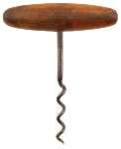10
About Corkscrews
This rather lengthy, but interesting article appeared in the
New York Sun
in 1884. Photos have
been added.
The corkscrew is a contrivance to facilitate the removal of corks from bottles. When a
cork protrudes from the neck of the bottle far enough to admit of grasping it with the
hand or clinching it with the teeth, a corkscrew is unnecessary. But when a cork is flush
with the bottle's mouth, or, through unskillful manipulation, has become lodged down
in the neck, a corkscrew is not only a convenience but almost a necessity. The bottle
may be emptied of its liquid contents by crowding the cork down through the neck
with a penholder or any other suitable article that may be at hand, but this method of
opening a bottle is generally regarded as inelegant.
There are several kinds of corkscrews. That which has been the
longest in use is the simplest. For several hundred years it was the
best, until a genius added an improvement which brought it to
perfection. The primeval corkscrew consisted of a wire, pointed at one
end, twisted into a spiral with about five turns tempered to give
rigidity to it, and provided with a wooden handle like that of a gimlet.
The spiral part of the wire was about two inches long after being
twisted, the part left straight was about the same length, and the
wooden cross piece was round, and about three inches in length and half an inch in
diameter. The handle was made fast to the metal by putting the wire through a hole in
the wood and clinching it. The metal was not burnished, nor was the wood polished or
painted. It is safe to say that there never was a corkscrew job which could not have been
accomplished with one of these primeval corkscrews.

